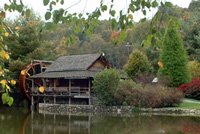 Hydroponic production of strawberries has many advantages. Could you name a few? (Image Source: USDA)
Hydroponic production of strawberries has many advantages. Could you name a few? (Image Source: USDA)INTRODUCTION
Up until this point we have focused primarily on 'traditional' greenhouse production. Production that involved horticultural crops being produced mostly in containers using soilless media as a root substrate.
You have been briefly exposed to hydroponic production through the EuroFresh videos, but there are several alternative production systems that are being utilized in commercial greenhouse businesses around the globe.
Some of these systems are even being further adapted by experts for extreme production locations such as the Antarctic, Moon, and Mars! You will see a few images from research in one of the slide presentations. This module will serve as a brief introduction into these systems which are growing in popularity.
LEARNING OBJECTIVES
- Briefly summarize three different types of Alternative Crop Production.
- Compare and contrast NFT with rock wool culture.
- Describe the function of the Ebb-and-Flood production system.
- Explain why the invention of Hoagland's solution was a breakthrough in the 1950's.
- List the advantages of the NFT system.
- Describe how rock wool is manufactured.
- List the advantages of rock wool production.
- Explain how whole firm recirculation can reduce the environmental impact of a greenhouse business.
nutriculture
hydroponics
NFT
rock wool culture
whole-firm-recirculation
ebb-and-flood
gravel culture
sand culture
In-line pasteurization
aquaponics
 Simple recirculating plant growth system utilizing materials that could be purchased from hardware and pet stores.
Simple recirculating plant growth system utilizing materials that could be purchased from hardware and pet stores.READING ASSIGNMENT
- Chapter 10. Alternative Cropping Systems. pages 369-385. In your textbook.
- North American Greenhouse Tomatoes Emerge as Major Market Force. A publication by the ERS/USDA.
Review the slide presentations below. The first reviews concepts from the reading. The second introduces you to an integrated agriculture system called aquaponics.
STUDY QUESTIONS (5 pts each, answer in complete sentences)
- Compare and contrast NFT with rock wool culture.
- Describe three different types of In-Line pasteurization of nutrient solutions.
- Briefly describe how rock wool is manufactured. How biodegradable is rock wool?
- How does irrigation frequency compare for traditional container systems and rock wool production?
- Briefly describe how whole-firm circulation might work for a greenhouse business.
- Based on the ERS article what percentage of tomatoes sold in grocery stores in the U.S. were produced in a greenhouse?
- What are some of the growing pains faced by the North American Greenhouse Tomato industry?
- A local greenhouse grower says that he can get ten times the yield of tomatoes from his greenhouse using the same amount of space as his competitor that grows field-grown tomatoes. Do you believe the grower or is this just hype? Support your answer.
- What North American country has the fastest growing production of greenhouse tomatoes and why?
- What North American country has seen a decline in greenhouse tomato production and why?
Continue with your greenhouse design project. Remember to contact your instructor if you have questions. The next assignment is available in PDF format here.




No comments:
Post a Comment